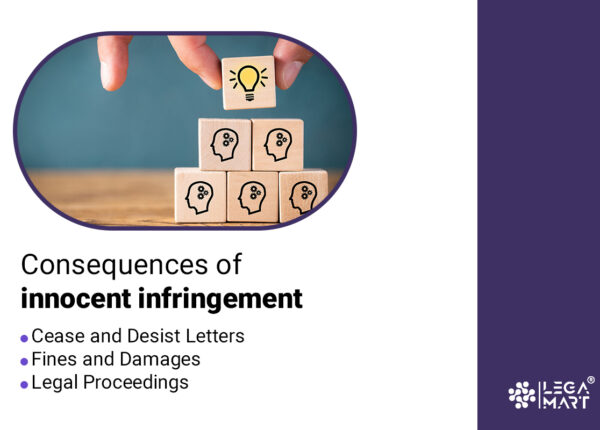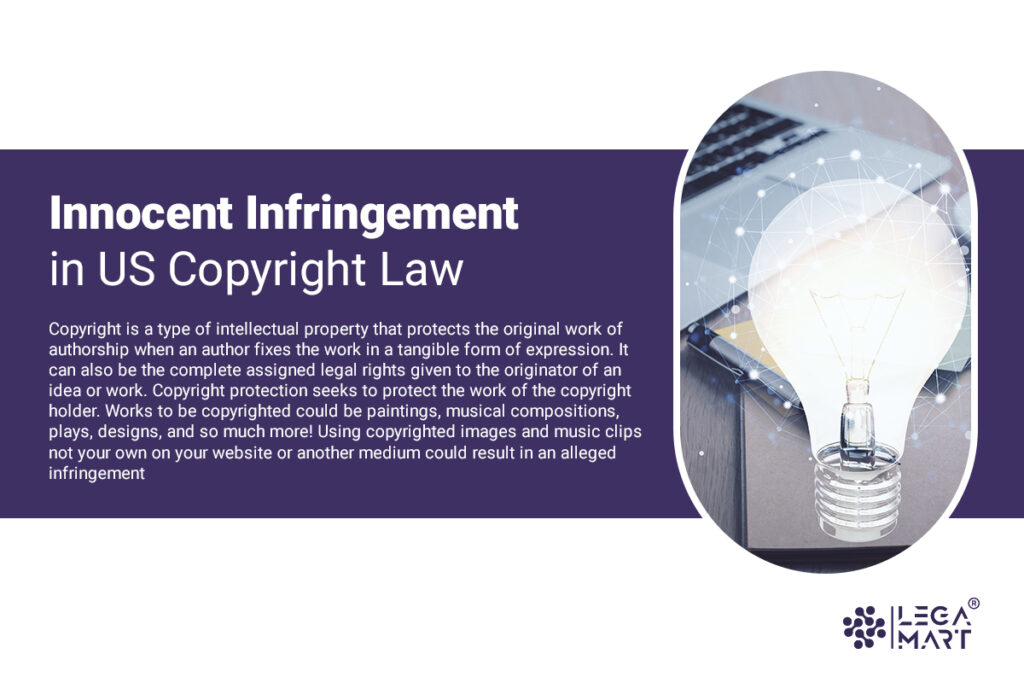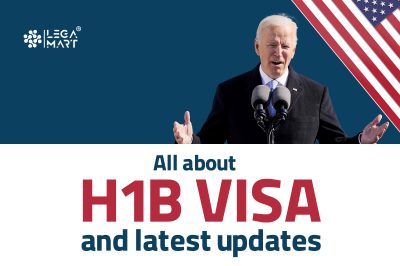Introduction
Copyright is a type of intellectual property that protects the original work of authorship when an author fixes the work in a tangible form of expression. It can also be the complete assigned legal rights given to the originator of an idea or work. Copyright protection seeks to protect the work of the copyright holder. Works to be copyrighted could be paintings, musical compositions, plays, designs, and so much more! Using copyrighted images and music clips not your own on your website or another medium could result in an alleged infringement.
A copyright infringement is an injury caused to intellectual property. This infringement harms what the law seeks to protect. Copyright Infringement can be defined as the reproduction, distribution, or display of any work without the consent of the originator. Even when the infringer was unaware and had no reason to believe they were violating copyright, the act can still be considered infringement. However, courts may reduce damages if they believe the infringement was innocent infringement or unintentional. Ignorance of the law or the copyrighted nature of a work doesn’t always shield one from penalties, but it can influence the severity of the consequences.
There are two forms of infringement: primary infringement (direct infringement by the defendant) and secondary infringement (which occurs if someone facilitates another person or group in infringing on a copyright).
Someone who knowingly induces, causes, or materially contributes to copyright infringement can be held liable as a contributory infringer if they knew or had reason to know of the infringement. Courts will determine whether a person or organization is vicariously liable to see whether the superior party (such as an employer) profited from the infringement of the primary or direct infringer and had supervisory authority over the direct infringer.
To enforce copyright, copyright owners typically send a cease and desist letter to the person or entity exploiting an exclusive right. In some cases, multiple cease and desist letters are sent. However, if correspondence fails, the copyright holder may sue in federal district court to enforce their rights. When a copyright is registered with the copyright office, the infringer may have to pay the copyright holder statutory damages and attorneys’ fees. An infringer will also be prohibited from continuing to use the work.
Copyright in the United States of America
Article 1, Section 8 of the 1787 Constitution of America stipulated the first copyright provision. It was in 1790 that Congress passed the Copyright Act.
The most recent statutory body governing copyright laws in the United States is the Copyright Act of 1976. It spelt out the rights of copyright holders and codified the doctrine of fair use. The Digital Millennium Copyright Act is a 1998 United States copyright law that implements two 1996 World Intellectual Property Organization treaties. It criminalizes the production and dissemination of technology, devices, or services intended to circumvent measures that control access to copyrighted works. Through Creative Commons, America has sought to expand the range of creative works available for others to build upon legally and to share.
Innocent infringement in the US
Copyright infringement could be an intentional, unintentional or willful infringement. Innocent infringement is one of the most used defences in copyright infringement litigation. Most people use this defence without knowing the ingredients that should be present in the offence committed to be able to employ this defence.
Often, people mistake unintentional infringement with an innocent infringement, believing that where the infringement was not intentional, they must be innocent infringers.
However, unintentional infringement is a requirement to use this defence. Section 504 provides for this defence when it spells out that the defendant not only “was not aware” that the work infringed the plaintiff’s copyright but also that they “had no reason to believe” that its use constituted infringement.
The US legal authority on this position has found that even unintentional infringers had reason to believe they were infringing where;
- Work contained a copyright notice
- Circumstances surrounding the defendant’s acquisition of the work were suspicious (e.g. internet downloading) and
- The nature of the work indicated that it likely was copyrighted material.
Statutory provision for the defence
Section 504(c)(2) of the Copyright Act covers the defence of an innocent infringement in US copyright law. The section provides that “in a case where the infringer sustains the burden of proving, and the court finds, that such infringer was not aware and had no reason to believe that his or her acts constituted an infringement of copyright, the court in its discretion may reduce the award of statutory damages to a sum of not less than $200.”
Common misconceptions of the defence
It is easy to develop misconceptions about the defence. Hence, there is a need to seek advice from a legal professional on issues relating to copyright. However, innocent infringement in US copyright law covers these misconceptions.
Many defendants who assert the innocent infringement defence believe it is a defence to innocent copyright infringement liability. This is not true. An innocent infringer is an infringer, nonetheless. The defence only comes into play when calculating statutory damages for the infringement. Section 504(c)(2) rightly covers this.
Another misconception is that the defence applies no matter the damages sought by the plaintiff. However, on innocent infringement in US copyright law, Section 504 does not provide for reducing an award of actual damages if the defendant proves they are an innocent infringer. Thus, a plaintiff seeking to avoid the availability of the defence should seek an award of actual damages under Section 504(b) instead of statutory damages under Section 504(c).
Innocent infringement in the US copyright law does not give room for this defence where there is a notice of copyright. Section 401(d), 402(d), and 404(a) of the US Copyright Act provide that an innocent infringement defence is barred as a matter of law where the work infringed contains a copyright notice. Even if the copy of the work the defendant obtained did not have a copyright notice (e.g. a pirated or downloaded copy), an infringer is not off the hook just yet. The court will examine whether the infringer can access an authorized copy of the work with a copyright notice. If not, the court will look at the circumstances in which the infringer gained access to the document (e.g. internet downloading).
Exceptions of liability to innocent infringement

We have seen from the common misconceptions regarding innocent infringement that the defence does not remove liability. An infringer is still an infringer. However, there are scenarios which remove the liability attached to innocent infringement.
- Instances where the lack of copyright notice misled the infringer and
- Instances where the infringing act occurred before the infringer received actual copyright notice.
Examples of innocent infringement to copyright
It is possible to claim the exception of innocent infringement in various scenarios. Some of them include:
- Using photos from the company’s website from a content management system. This scenario is part of a recent case wherein a woman used one of the photographs available on the company’s website. The content management system being used included a stock photo library from which the employer paid for the usage of the photographs. The woman had assumed that the pictures had been appropriately licensed by the company. However, that was not the case. This resulted in the photo owner suing her for infringement. Here, the court held that the defence of innocent infringement should be applicable since the woman did not know and had no reason to believe she was using someone else’s copyright.
- Using copyrighted music in videos. Most commonly seen on YouTube, wherein vlog creators are using popular copyrighted music. However, not everyone shall know that the fair use exception to copyright does not cover all instances of copyrighted music being used in music videos. In such a case, innocent infringement is applicable.
- Sharing copyrighted content on social media. The majority of the population currently is on social media, and people share and reshare a range of photographs and other artistic works on their social media profiles. However, expecting everyone to be familiar with copyright status is unrealistic. In such a case, you can use the innocent infringement defence.
Consequences of innocent infringement

While you can claim innocent infringement as a defence, the truth remains that your actions have led to some copyright infringement, regardless of whether you intended to do so or not. Therefore, you still have to bear the legal and financial consequences of your actions, though the magnitude of their applicability is significantly reduced due to this defence. Some consequences that you might face even after proving innocent infringement are:
- Cease and Desist Letters – This includes a notice for immediately removing the infringing material.
- Fines and Damages – Depending upon the severity of the infringement, you can be asked to pay substantial monetary damages.
- Legal Proceedings – Even after the defence, if the copyright holder decides to continue to pursue legal action, you can find yourself involved in costly litigation proceedings.
How to avoid innocent copyright infringement?
To stay protected against innocent copyright infringement claims, you would be required to develop awareness and conduct proper due diligence to avoid any innocent infringement. Some common ways to do so are:
- Learning applicable copyright laws – Familiarize yourself with the applicable copyright laws to your jurisdiction. Understand the rights of copyright holders and the applicable exceptions and limitations of fair use exceptions.
- Obtain proper permissions – If you plan to use any copyrighted material, ensure that you get adequate permissions from the copyright owner, irrespective of who the person is. Further, ensure that the document mentioning the grant of such permission is securely kept for any future reference.
- Use public domain and Creative Common Licensed Content – The best way to avoid copyright infringements is to use content offered on public domains. These materials are often free and have fewer or no usage restrictions.
- Perform proper due diligence – If you are unaware of the copyright status of any work, conduct thorough research to understand it. You should check for any licenses, watermarks, or copyright statements being used with the work, which might give the impression that they are someone else’s intellectual property.
- Attribute properly – If you are using any copyrighted material, irrespective of whether you have taken permission, it is always beneficial to provide proper credits/attributions to the original owner of the copyright. This protects you from any infringement claims and demonstrates a sense of respect for the work.
Conclusion
The United States Copyright Office, a part of the Library of Congress, is the official US government body that maintains records of copyright registration in the United States, including a copyright catalogue.
Copyright protects the creator’s rights and provides incentives and economic benefits to the copyright owners. Copyright extends to the literary or artistic works which demand creativity. Get your work copyrighted with the help of lawyers at LegaMart.
The registration of work is not necessary to be eligible for copyright. However, it is often advised to register the work because it serves as evidence in court.
Frequently asked questions (FAQs)
How can you prove that infringement was innocent?
To be covered under the defence of innocent infringement, the parties are required to prove that they were not just unaware of their infringing act but did not have any reason to believe that their actions were wrong. Therefore, the threshold required to be proved is much higher to claim innocent infringement than simply claiming the infringement to be unintentional, where you are only required to prove that you were unaware of your infringing act.
Is it possible to use fair use protection against innocent copyright infringement claims?
The doctrine of fair use allows users to use copyrighted materials for limited purposes without taking permission from the copyright owner. However, this is not a blanket defence that can be used over all infringement claims. Therefore, you would be required to prove a range of factors to apply fair use protection, such as the purpose and character of the use, nature of work, amount used, and effect on the marketability of the original work.
Is innocent infringement a criminal offence?
No, innocent infringement is usually not treated as a criminal offence. Rather, it is treated as a civil offence and helps the copyright owner obtain damages.




